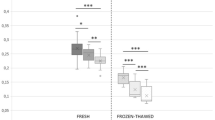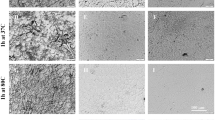Abstract
THE finding that the addition of glycerol to semen increases considerably the proportion of spermatozoa which survive freezing and storing at − 79°C.1,2 opened up the question as to whether or not glycerol can be metabolized by the intact sperm cells. Early-experiments indicated that, unlike certain glycolysable sugars and organic acids, glycerol, in common with other alcohols, has no marked initial-rate preserving effect on the sperm respiration3, and exerts its action mainly through a protective influence on sperm colloids, probably owing to its high electrolyte- and water-binding capacity4,5. More recent investigations, however, have shown that although glycerol does not affect sperm motility and respiration in a diluent containing fructose, it increases markedly the oxygen consumption of washed sperm suspensions, giving rise at the same time to significant quantities of lactic acid6. It has also been demonstrated that glycerol labelled with radioactive carbon enters spermatozoa in measurable amounts; sperm cells separated from the seminal plasma showed a higher uptake and. utilization of glycerol than did spermatozoa in the presence of seminal plasma7. The present study was undertaken to investigate : (1) the relationship between glycerol disappearance and lactic acid formation ; (2) the behaviour of compounds related to glycerol such as dihydroxyacetone and phosphoglycerol. Glycerol was determined colorimetrically8, and the other methods used were those described earlier9.
This is a preview of subscription content, access via your institution
Access options
Subscribe to this journal
Receive 51 print issues and online access
$199.00 per year
only $3.90 per issue
Buy this article
- Purchase on Springer Link
- Instant access to full article PDF
Prices may be subject to local taxes which are calculated during checkout
Similar content being viewed by others
References
Polge, C., Smith, A. U., and Parkes, A. S., Nature, 164, 666 (1949).
Polge, C., and Rowson, L. E., Vet. Rec., 64, 851 (1952).
Humphrey, G. F., and Mann, T., Biochem. J., 44, 97 (1949).
Lovelock, J. E., and Polge, C., Biochem. J., 58, 618 (1954).
Mann, T., “The Biochemistry of Semen” (Methuen, London, 1954).
White, I. G., Blackshaw, A. W., and Emmens, C. W., Aust. Vet. J., 30, 85 (1954).
O'Dell, W. T., Flipse, R. J., and Almquist, J. O., J. Dairy Sci., 39, 214 (1956).
Ryley, J. F., Biochem. J., 59, 353 (1955).
Mann, T., Biochem. J., 40, 481 (1946).
Author information
Authors and Affiliations
Rights and permissions
About this article
Cite this article
MANN, T., WHITE, I. Metabolism of Glycerol, Sorbitol and Related Compounds by Spermatozoa. Nature 178, 142–143 (1956). https://doi.org/10.1038/178142b0
Issue Date:
DOI: https://doi.org/10.1038/178142b0
This article is cited by
-
Lipid Metabolism is Closely Associated with Normal Testicular Growth Based on Global Transcriptome Profiles in Normal and Underdeveloped Testis of Obese Zucker (fa/fa) Rats
Lipids (2017)
-
Further Investigations of the Carbohydrate Metabolism of Cock Spermatozoa
Nature (1962)
-
Sorbitol Dehydrogenase in Spermatozoa
Nature (1958)
-
The effect of glycerol on the biosynthesis of benzylpenicillin by the washed cells of
Experientia (1958)
Comments
By submitting a comment you agree to abide by our Terms and Community Guidelines. If you find something abusive or that does not comply with our terms or guidelines please flag it as inappropriate.



